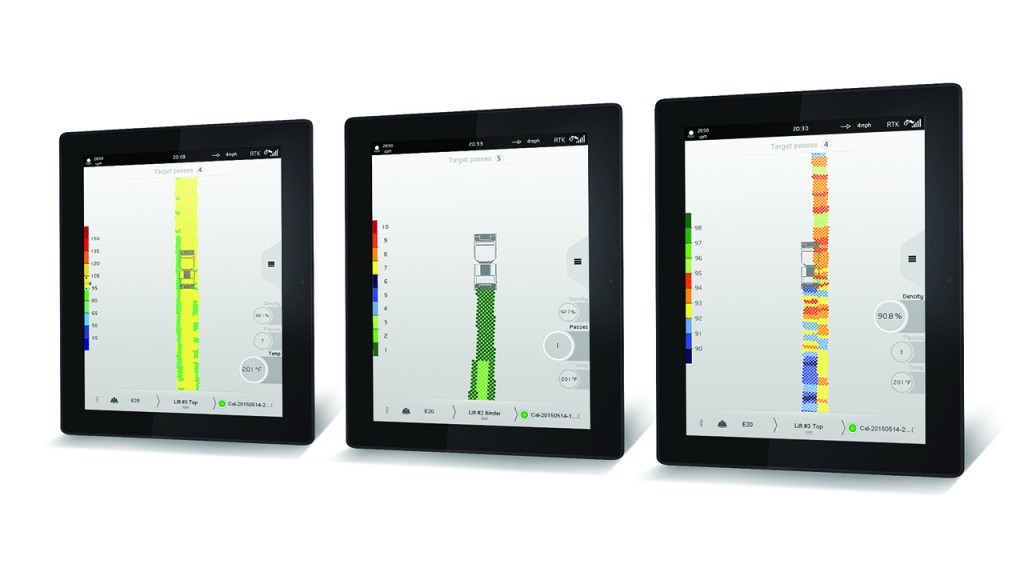
One of the most recent technological innovations in paving equipment is Intelligent Compaction (IC). IC features pass mapping and temperature mapping technology, which gives operators real-time information, including how many passes they have made over a certain area and the temperature across the mat. With its capabilities, IC offers opportunities to dramatically reduce the guesswork and improve quality control by the operator during the paving process. The value of IC is well recognized by many states and agencies in the U.S. but adoption in Canada has not taken off.
Change, no matter how positive, is often met with resistance, and the road paving industry is no exception to this rule. For example, in the United States, many of the industry's milestone advancements have been a result of Federal Highway Administration-funded testing programs that proved the value of new technologies. Subsequently, individual states see the value and have begun mandating the use of these new technologies on federal and state-funded highway projects. As of spring 2017, a total of 23 states in the U.S. have implemented (to varying degrees) an IC specification.
This has resulted in the need for more paving contractors with IC experience in the U.S., prompting many contractors to quickly familiarize themselves with the technology. While this is a positive step toward improved roads, contractors in these states are now faced with either investing in IC systems or losing out on bids that require them.
Contractors serving the Canadian roadbuilding industry must take note. Even without agency specifications, contractors can still benefit from the use of IC through higher quality and more efficient roadbuilding.
It is important for contractors to familiarize themselves with the numerous benefits of IC prior to a shift in roadbuilding specifications from agencies in order to stay ahead of the competition.
How IC works
IC systems feature an accelerometer-based measurement system, as well as GPS, infrared temperature sensors, and an on-board computer that provides real-time compaction information to the operator. The primary features of IC systems - common among all providers - are pass mapping, surface temperature mapping and data collection.
• Pass Mapping - IC systems provide real-time information to the operator, showing how many passes have been completed and ensuring the operator can gain better uniformity across 100 percent of the mat. Over-compaction is equally as detrimental to quality as under-compaction, and pass mapping can help ensure the operator isn't making too many or two few passes.
• Temperature Mapping - IC systems display real-time pavement surface temperature information to the operator. This is incredibly important, as the temperature greatly impacts the material's ability to be compacted. Armed with real-time temperature information, a skilled compactor operator will know to make adjustments to the distance behind the paver in order to compact the asphalt at peak temperatures and avoid the need for additional passes that can drive up project costs and extend timelines.
• Data Collection - In the U.S., the FHWA recognized that IC data could provide significant value for quality control protocols. Of critical importance, however, was ensuring that data was collected and reported in a standard format among all manufacturers' IC systems. Thus, the FHWA recommended that all systems export data in a standard format for use in a program called VETA - a map-based software originally funded by both FHWA and Minnesota DOT.
While these three features are more or less standard across all IC systems, what varies significantly between systems is how the system calculates the Intelligent Compaction Measurement Value (ICMV) - essentially a measurement of asphalt stiffness. The majority of IC systems offer real-time asphalt ICMV calculations; however, each manufacturer has a slightly different methodology for how it's done.
Despite the variance in calculations between manufacturers, each has the same goal in mind - to equate ICMV to density. This correlation (or lack thereof) between ICMV calculations and real-world asphalt density values has been subject to a great deal of scrutiny in the past several years.
Comparing ICMV and density
In 2014, FHWA released a report about a study that attempted to identify a clear correlation between ICMV calculations and in-place asphalt densities. The study involved IC testing and evaluation on asphalt paving projects throughout nine states on IC systems from manufacturers including Hamm, BOMAG, Caterpillar and Sakai. These calculations were then compared to actual asphalt density values from core samples. After two years of testing and evaluation, the FHWA released a 321-page report in December 2014 outlining their findings.
FHWA: ICMV ≠ density
The report found that ICMV values alone cannot reliably predict core densities, stating, "The pass-by-pass ICMV correlate well with nuclear density gauge measurements during breakdown compaction. The final ICMV does not correlate well with core densities."
Numerous factors are cited in the lack of correlation, including measurement depths, footprints and a change in drum rebounds when asphalt temperatures drop below a certain threshold. The report does, however, insist that IC systems "can be used as an enhanced tool for quality control by monitoring ICMV in real time during construction in order to maximize the window of opportunity for compaction."
Entering a new age
In 2008, the FHWA devoted $200,000 under the Highways for LIFE Technology Partnerships program with the University of Oklahoma (owner of multiple patents for this technology) for studying an alternative method of determining density. This technology came to be known as Density Direct, a real-time density estimation tool. It is available exclusively on Volvo Compact Assist, Volvo's Intelligent Compaction system.
Density Direct was tested on various full-depth and overlay asphalt pavement projects and later evaluated at independent sites throughout the country. The results were overseen by University of Oklahoma researchers and showed that Density Direct calculations correlated well (overall compaction results R2 = .754) to extracted core densities.
Density Direct in practice
Within the Compact Assist system is a calibration screen, where the user sets the range of densities that are based on the mix design sheet for the lift being constructed. Calibrations are also saved, so operators can assign and quickly switch back and forth between calibrations to certain elements of a job.
The Co-Pilot user interface of Volvo's Compact Assist system depicts an estimated density map, showing each square unit of rolled surface in a colour representing density, and also provides real-time numerical readings of density, surface temperature and pass count displayed on one side of the screen. The pass mapping function captures each compactor pass and drum overlap with a different colour, so that the operator can easily see gaps and work to maintain uniform coverage. Temperature mapping shows the operator the path of the compactor overlaid with the recorded surface temperature.
Regardless of which IC system a road contractor chooses, one thing is clear: road contractors that use IC are in a better position to win bids and are better able to make quality control decisions during the compaction process.



